Armchair GM New York Rangers roster review: Part 1 – Centers

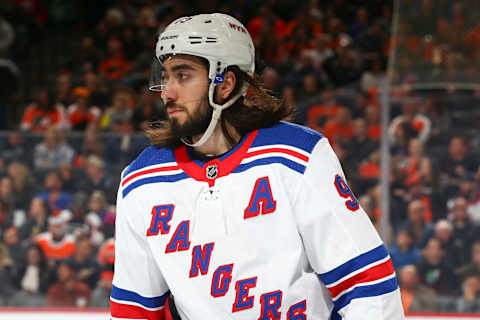
New York Rangers: Strength Up the Middle?
With the New York Rangers being unceremoniously dispatched from the COVID-19 induced Qualifier round, winning the Draft Lottery and with a flat cap going into the next season, it is time to play armchair GM. Realistically, could there ever be a better, more exciting time? The Rangers have the building blocks of a dynamic core for the foreseeable future and many assets that can be leveraged to add a solid group of depth and role players to build a Cup contender for many years to come.
The future is bright, for sure, but the here and now is less certain. The team needs to rely on their young players to step up to the next level, but can they? The team also needs to be much harder to play against, so while all the skilled players and prospects the team has are fun to watch, is that how the team should be constructed? Can players that peaked this year continue to play at such a high level? And are the teams free agents worth retaining, and if so, at what cost?
Each player will be primarily judged on their hockey impact and/or asset value to the team both now and for the immediate future. The analysis will be based on current position, depth at said position, production, trade value (including contract clauses) and finally chemistry. Both salary cap and contract implications will be factored in as each players financial impact cannot be ignored and will be based on what may be expected for each player to be worth on the open market.
This will be the first of a five part series, where we will be looking at the New York Rangers by position. We will start with what many hockey observers consider the most important building block for success, strength up the middle. We will then look at the wings, defense and finally, goaltending.
So … Let’s dive right in with centers …
#93 Mika Zibanejad
Mika Zibanejad is by far and away the best center and arguably the most important player on the team. From playing in all situations, leading the team in goals, power play goals and points, short-handed goals and points, being tops among forwards in time on ice, and producing points at a pro-rated 108 points over 82 games, Zibanejad has proven he is not only a top line center, but a bonafide NHL star.
His only problem is being prone to injury. Over his first four seasons, he has missed 49 games. His first season in NY he played only 56 games after suffering a broken ankle sliding into the end boards. He suffered a concussion in his second season and missed 10 games. In both cases, he was off to quality starts, posting near point per game numbers, before the injuries derailed his production pace (2016-17, 15 points in 19 games and in 2017-18, 22 points in 24 games) … playing catch-up upon his return didn’t work so well for him. Last season, being a healthy and injury free, Zibanejad had a career year establishing himself as a top line center and the first Ranger since Marian Gaborik in 2011-12 to reach the 70 point plateau.
This season Zibanejad missed another 13 games with a neck injury, but unlike his first two years, he excelled when he returned and established career highs in Goals (41) and Points (75) in only 57 games played.
In the end though, it is a pretty easy decision. Zibanejad stays, hands down and should probably get the C …
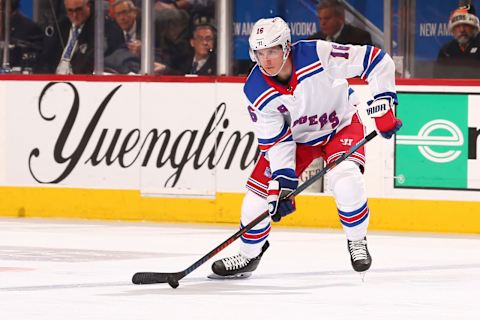
#16 Ryan Strome
The second line center for most of the season, Ryan Strome found a sweet spot for chemistry with the Artemi Panarin, his usual left wing. That chemistry led to Strome putting up career best numbers in assists (41) and points (59), while his 18 goals fell only one short of tying his career high, all during this COVID-19 shortened season.
The questions about Strome continually circle around his chemistry with Panarin and his previous career stat line of just under 38 points a season on average, from his debut in 2013-14 through the 2018-19 season. Is Strome simply a late bloomer, who at 26 has finally found the game that had him drafted #5 overall in in 2011? Or is this a career spike, much like Derick Brassard who put up career numbers in 2014/15 and 2015/16 before his production regressed to more closely resemble his career averages?
Chemistry is a fickle thing, and finding the correct linemates that bring out the best in each other can be a coaching nightmare. So once you find it, it’s best to stick with it. That said, is the chemistry between Panarin and Strome mutually beneficial? Meaning, does Panarin need Strome to be the success story he has been to this point as much as Strome has needed Panarin? This is not to suggesting that Strome has been leeching production off his left wing, but 34 of his 59 points on the season (57.6%) and 13 of his 18 goals share the scoresheet with Panarin. Conversely, Strome only shared the scoresheet on 35.7% of Panarin’s points while assisting on only 10 of his 32 goals. It’s easy to see that Strome has been the greater beneficiary of their on-ice relationship.
Additionally, as a Restricted Free Agent (RFA) and with Filip Chytil and several NCAA centers ready to compete for jobs, how much is that not so quite two-way street relationship worth? As a comparable, Kevin Hayes with one 50 point and one 20 goal season received a $7 million/7 year contract, which is far too much to pay for a player that should project to be a future third liner for this team. That said, keeping the RFA on a one year deal, max, to give Chytil more time to grow may be a prudent decision. That means he’ll be an Unrestricted Free Agent (UFA) at the end of the 2020-21 season, opening the possibility of a deadline deal that could net a similar return as the Hayes deal did.
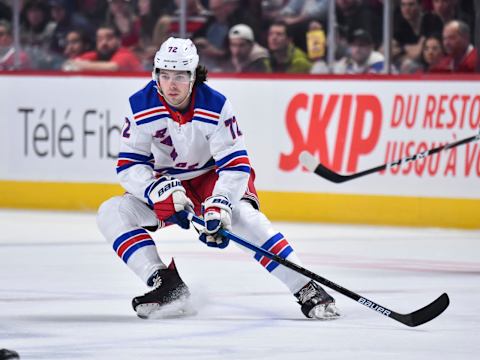
#72 Filip Chytil
In his second full season, while still only 20 years old, Filip Chytil improved his game in virtually every category, but especially with his play away from the puck. After starting the season in Hartford, Chytil was called up and made immediate strides on the scoresheet, scoring six goals in his first eight games, including the game winner against Tampa in his first game of the season on October 29, 2019. Overall, in 15 fewer games than his rookie season, Chytil produced the same number of points (23), with a career high in goals (14), an average of a minute more ice-time per game and a significantly better plus/minus (+/-) with a positive Relative Corsi.
It should also be noted that he scored 20 of his 23 points at even strength and his effect on Kappo Kakko’s game away from the puck was significant. Kakko finished as a -26 and was a -12 in October alone. It is no coincidence that Chytil’s arrival at the end of October also coincided with the right wing’s improved plus/minus.
The sore point for Chytil though is his inability to win faceoffs, which has not improved and was in fact worse. The 2019-20 season saw the Czech Center register a winning percentage of 38.4%, half a point less than the previous season at 38.9%.
That said, another season as the team’s third line center certainly would not hurt. Then, as the organization has done previously with Derek Stepan, Derick Brassard and Kevin Hayes, the move from third line to second line center is inevitable. The difference between Chytil and those previous centers is age. Chytil will be 21 when the next season begins, as Stepan was when he was bumped up, but Hayes (24) and Brassard (27) were significantly older when they became the Rangers second line center..
I view #72 as the future 2C of the team, it’s just a matter of when, and that answer will be directly influenced by or will directly influence the decision to be made with Ryan Strome, as noted above.
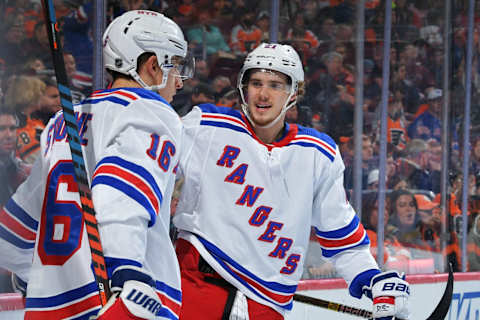
#21 – Brett Howden
Outside of a strong 13 points in 23 game start to the 2018-19 season, Brett Howden has been rather invisible and has not lived up to the hype that came with him in the Ryan McDonough trade. He plays the game the right way, has been one of the teams better faceoff men and David Quinn constantly refers to his “intentions” on the ice. but is that enough? Honestly, no. In fact he lost his spot at center and he has not shown enough to believe he will regain it, outside of an in-game line mix-up as we saw during the Qualifier round.
Can he be a quality depth forward? Sure. With just over 13 minutes of ice time averaged per game, Howden still listed in the top ten on the team in both hits and blocks. With one year remaining on his entry level contract (ELC), it is worth a look to see if he can improve his production.
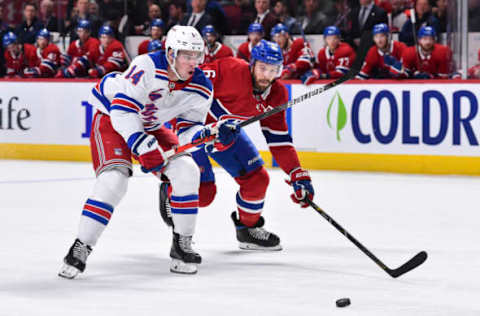
#14 – Greg McKegg
He’s not going to light the world on fire, but he has speed and is at least decent in the faceoff circle. But as a 28 year old UFA, even at the league minimum, is it worth it for the team to make commitment as opposed to going younger? I think he deserves a shot to battle for a spot, but only as a cheap free agent signee.
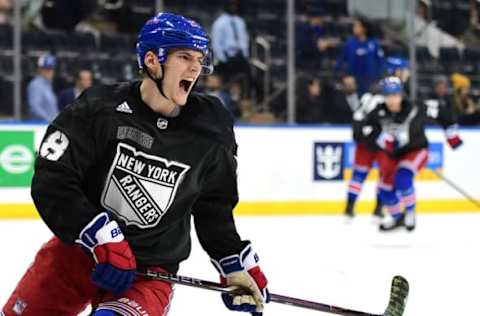
#28 – Lias Andersson
The history between player and team is well documented. Lias Andersson will need to show a lot to the team, the fans, himself and the NHL as a whole to prove he belongs on NHL ice. Hopefully a full season in the SHL will provide positive results that increase his stock as a player, either for a recall or in value as trade asset. When Andersson’s next chance arises, if that chance is even with the Rangers, it may be his last.
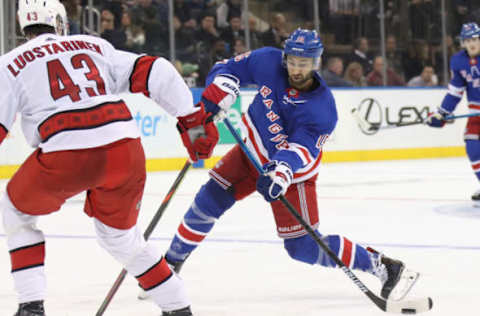
#15 – Boo Nieves
While Nieves may have potential, he only played in four games this season after appearing in 43 and 28 contests the last two seasons. He was not added to the extended postseason roster and is a UFA. We’ve seen the last of Nieves in a Rangers uniform.
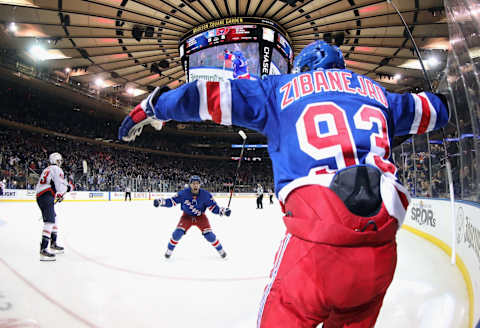
Summing up the center position
The New York Rangers position at center is still full of questions marks that need to be addressed. Barring a trade, however, it should be expected that the center depth seen this season will resemble something close to what David Quinn has to deploy onto the ice next season.
The team is set at the dot with Zibanejad and Chytil moving forward. Both players will be up for new contracts in the very near future. Chytil’s ELC deal expires at the end of next season after which he will be a restricted free agent. Zibanejad, currently on an extremely team friendly deal, will be due a large pay increase after the 2022-23 season. Signing him to an extension, possibly as early as next season would be a wise decision. John Davidson and Jeff Gorton cannot allow Zibanejad to reach unrestricted free agency.
Looking ahead, possibly as early as the upcoming 2020-21 season, but certainly no later than the 2021-22 season, the Blueshirts will have a new look center group with players like Morgan Barron, Patrick Khodorenko, Justin Richards and Karl Henriksson, all pushing for spots on Broadway.
Thanks for reading.
Up next: We’ll look at the position most positively impacted by the expected arrival of Alexis Lafrenier, the left wing.
More. How the pandemic will affect prospects next season. light